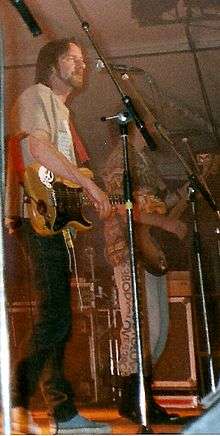Alan Hull
| Alan Hull | |
|---|---|
 Alan Hull on stage with Lindisfarne in 1991 | |
| Background information | |
| Birth name | James Alan Hull |
| Born |
20 February 1945 Benwell, Newcastle upon Tyne, England |
| Died |
17 November 1995 (aged 50) Newcastle upon Tyne, England |
| Genres | Folk rock |
| Instruments | Vocals, rhythm guitar, keyboards |
| Years active | Mid 1960s–1995 |
| Associated acts |
Lindisfarne The Chosen Few Skip Bifferty |
James Alan Hull (20 February 1945 – 17 November 1995)[1] was an English singer-songwriter and founding member of the Tyneside folk rock band Lindisfarne.
Career
Hull was born at 68 Sutton's Dwellings, Benwell, Newcastle Upon Tyne.[2] He attended Rutherford Grammar School, Newcastle after passing the eleven-plus in 1956 and was given a guitar at the age of twelve. Hull wrote his first song soon afterwards.[2]
He became a member of the band The Chosen Few alongside keyboard player Mick Gallagher in 1962. He supported himself by working as a window cleaner,[3] one year by working as a nurse at a mental hospital and as a driver for Newcastle Co-op TV Departnment while appearing as a folk singer and guitarist in local clubs before helping to form Brethren and Downtown Faction, which evolved into Lindisfarne in 1970. He also released a one-off solo single, "We Can Swing Together", which was re-recorded with the group on their first album, Nicely Out of Tune, and became a regular favourite in their stage performances.[4]
As the group's most prolific songwriter and joint lead vocalist, Hull came to be regarded as its leader. In 1972, dissatisfied with the sound and critical reception of their third album Dingly Dell, he considered leaving the group but instead he and joint lead vocalist Ray "Jacka" Jackson formed a new six-piece Lindisfarne the following year, leaving the three other original members to form Jack The Lad. He also released his first solo album, Pipedream, the same year and published a book of poems, Mocking Horse.[4] Alan Hull appeared in "Squire", an episode of the BBC's Second City Firsts drama series.
Lindisfarne disbanded in 1975 and Hull released a second solo album, Squire, then formed the short-lived Radiator, which also included drummer Ray Laidlaw of Lindisfarne and Jack the Lad. At the end of 1977 the original line-up of Lindisfarne reformed after a well-received Christmas show at the Newcastle City Hall which was broadcast on local radio. Thereafter he combined his musical career as front man of the group with a solo career.
He was also a staunch Labour Party activist.[4] For a time he was secretary of his local constituency Labour Party. He performed in Blackpool to coincide with the Labour Party conference in 1990 and played at numerous benefit concerts for striking or redundant miners and shipyard workers.[2]
In January 1994, he recorded Back to Basics, a live all-acoustic survey of the best of his songwriting from 1970 onwards.
On 17 November 1995, whilst working on a new album, Statues & Liberties, Alan Hull died suddenly of a heart thrombosis, at the age of 50.[4] After his death, Hull's ashes were scattered at the mouth of the River Tyne.[2]
On 19 July 2012, following a public campaign led by Barry McKay, Lindisfarne's manager during the 1970s, an Alan Hull memorial plaque was unveiled on the front of Newcastle City Hall, at a ceremony attended by hundreds of fans and broadcast by filmed by Sky and ITV Tyne Tees.[5]
Personal life
He married Patricia Sharp on 22 August 1966, and they had three daughters.[2]
Solo discography
Singles
- "We Can Swing Together" / "Obadiah's Grave" (1970)
- "Numbers" / "Drinking Song" / "One Off Pat" (1973)
- "Justanothersadsong" / "Waiting" (1973)
- "Dan The Plan" / "One More Bottle of Wine" (1975)
- "One More Bottle of Wine" / "Squire" (1975)
- "Crazy Woman" / "Golden Oldies" (1975)
- "I Wish You Well" / "Love Is The Answer" (1979)
- "A Walk in the Sea" / "Corporation Rock" (1979)
- "Malvinas Melody" / "Ode to a Taxman" (1983)
Albums
- Pipedream (1973) UK No. 29[1]
- Squire (1975)
- Phantoms (1979)
- On The Other Side (1983)
- Another Little Adventure (1988)
- Back to Basics (1994)
- Statues & Liberties (1996)
- When War Is Over (1998)
- We Can Swing Together - Anthology (2005)
- Phantoms (CD release with bonus Tracks) (21 May 2007)
- Live at Clifton Poly 1975 (2009)
References
- 1 2 Roberts, David (2006). British Hit Singles & Albums (19th ed.). London: Guinness World Records Limited. p. 262. ISBN 1-904994-10-5.
- 1 2 3 4 5 Oxford Dictionary of National Biography - Dave Laing
- ↑ http://www.propergandaonline.com/howay-the-lad/
- 1 2 3 4 OBITUARY: Alan Hull – People, News – The Independent
- ↑ "Lindisfarne Founder'S Memory Honoured at City Hall. – Free Online Library". Thefreelibrary.com. Retrieved 12 December 2012.